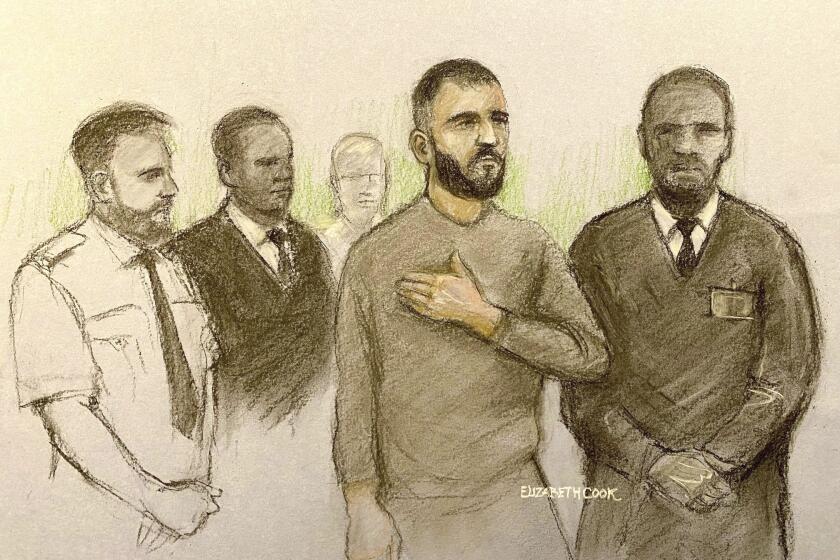Haiti effort to get a boost from added airfields, seaport reopening
Reporting from Port-Au-Prince, Haiti, and Mexico City -- U.S. military officials in Haiti said Thursday that the use of three additional airfields and the capital’s seaport would boost of the flow of food, water and medical attention to earthquake victims -- at least half a million of whom, according to one count, are scattered in more than 400 camps around Port-au-Prince.
Air Force Gen. Douglas Fraser, commander of the U.S. Southern Command, said the military had begun using two airfields in the neighboring Dominican Republic and one south of Port-au-Prince, which was devastated in the Jan. 12 quake.
The move is aimed at taking some of the burden from the Port-au-Prince airport. Now run by the U.S. military, it is handling 120 to 140 flights a day, but there is a waiting list of 1,400 flights, Fraser said.
Port-au-Prince’s seaport was closed because of heavy quake damage. Fraser said the arrival of a landing craft with “port-opening” capabilities would allow it to reopen on a limited basis. The port should be able to handle as many as 250 containers a daystarting today, when a commercial ship is to arrive.
Seaborne shipments are expected to dramatically increase the quantities of goods and equipment for the relief and recovery effort.
As the flow of help increased, doctors scrambled to take care of the thousands of injured Haitians who have overwhelmed clinics and field hospitals.
At the busy downtown General Hospital, Dr. Bob Norris worked in the blazing sun, getting seriously injured patients transported to a landing pad at the presidential palace for transfer to the Comfort, a U.S. Navy hospital ship anchored offshore.
“That’s 40 out the door so far. You guys are rockin’,” Norris told Army 1st Sgt. Brian Knight, 33, whose crew of soldiers loaded military ambulances.
“Got another one coming,” Knight shouted. Four soldiers quick-stepped a stretcher bearing Dorival Danielle Edelyne, 20. Her back was broken when her house collapsed, and she had been at the hospital for a week.
“Right side, right side,” Knight said, as a 10-year-old girl with a pelvic injury was loaded aboard. “OK, hold up there. Give them a second.”
Next was Eliacin Gaston, 24, a bystander who was shot in the head Thursday morning as police officers fired at looters.
“We felt he was salvageable, so we’re moving him right out,” said Norris, 52, head of the emergency room at Stanford University Medical Center, who is working here with the International Medical Corps.
“We’re seeing a lot of people from the outer provinces now, people who have waited until today,” said Gabriella McAdoo, a nurse working with the IMC, the primary relief agency operating at the hospital. “Some also are coming just to make sure they’re OK. Our doors are open to all of them.”
On a winding street near downtown Port-au-Prince, hundreds of Haitians formed thick lines Thursday that stretched for several blocks, hoping to receive cash from family members abroad.
The scene was tense at the C.A.M. money transfer office, where angry customers started shouting as the owner began to close the doors at midafternoon.
“The money is here; we’ve got to get it,” one man shouted.
“They must stay open at least another hour,” shouted another.
Pierre Paul Mondesir, the chief of security, seemed to sympathize.
“Many of them have been here since 9 this morning,” he said. “The situation is hard. They need money, they need food. So of course they come.”
As he spoke, Michael Boereau, 52, who hoped to collect money his brother had wired the day before from New Jersey, shouted, “How can they close like this?” Boereau had been in line for five hours.
He and his family of five lost their house and were living on the street.
“For 10 days, we haven’t gotten any help,” he said. “I have only these clothes on my back. That’s why I need money -- for some clothes.”
Eventually the police took the names of about 100 people still waiting outside when the office closed, promising to give them priority when they returned the next day.
Aid groups and foreign governments continued to try to meet the staggering need for food, water and medical care. U.S. troops, which now number 12,000 but are expected to reach 20,000 by the weekend, deployed around the capital and its outskirts to deliver goods and move the most gravely injured to the Navy’s hospital ship.
An estimated 1 million Haitians are believed to have been left homeless by the magnitude 7.0 earthquake.
The International Organization for Migration said Thursday that 447 “improvised settlements” have popped up in Port-au-Prince, where at least 500,000 people have gathered. Out of 350 of the sites, only three had potable water, the organization said.
News reports said the government planned to move 400,000 homeless people to tent villages that are to be set up on the outskirts of Port-au-Prince. Interior Minister Paul Antoine Bien-Aime said the first phase would be to move 100,000 displaced people to camps that can hold 10,000 each.
“Tents will not work in May when the long rainy season begins and later when the hurricane season starts,” said Vincent Houver, the migration organization’s mission chief in Haiti.
“But at this point there is not much choice.”
More to Read
Start your day right
Sign up for Essential California for news, features and recommendations from the L.A. Times and beyond in your inbox six days a week.
You may occasionally receive promotional content from the Los Angeles Times.







